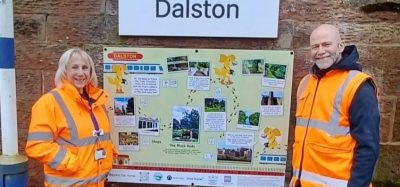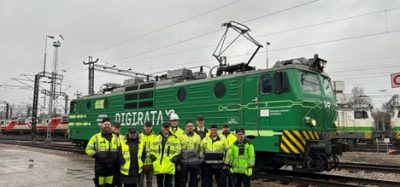High-tech solution for ÖBB operation control
Posted: 21 July 2009 | | No comments yet
ÖBB-Infrastruktur Betrieb AG is a modern and customer-oriented infrastructure operator allowing the 22 railway undertakings authorised to operate in Austria access to ÖBB’s approximately 5,700km-long railway network. To this end, ÖBB’s operation control strategy plays a decisive role. ÖBB heralded a new high-tech era with the launch of the operation control centre in Innsbruck at the end of 2008.
ÖBB-Infrastruktur Betrieb AG is a modern and customer-oriented infrastructure operator allowing the 22 railway undertakings authorised to operate in Austria access to ÖBB's approximately 5,700km-long railway network. To this end, ÖBB's operation control strategy plays a decisive role. ÖBB heralded a new high-tech era with the launch of the operation control centre in Innsbruck at the end of 2008.
ÖBB-Infrastruktur Betrieb AG is a modern and customer-oriented infrastructure operator allowing the 22 railway undertakings authorised to operate in Austria access to ÖBB’s approximately 5,700km-long railway network. To this end, ÖBB’s operation control strategy plays a decisive role. ÖBB heralded a new high-tech era with the launch of the operation control centre in Innsbruck at the end of 2008.
Aspects of quality, operating reliability and non-discrimination towards these customers as well as the safeguarding of cost effectiveness, productivity and efficiency form the basis of our operational and strategic work.
The tasks of ÖBB-Infrastruktur Betrieb AG include the provision, operation and maintenance of a safe infrastructure in line with demand. The objectives are the continuous improvement of the infrastructure’s quality and safety and the increase of productivity. The potential for streamlining results from the technical and organisational measures and the use of innovative systems.
Another benchmark for the quality of our work is operating safety, which we ensure with targeted internal and external measures and initiatives. The consistent implementation of our operation control strategy, allowing a further enhancement of safety by mechanising processes, results in valuable synergies and is complemented with extensive safety programmes. The customer benefits from the enhanced safety and quality made possible by an increase of the level of automation and the use of new passenger information systems. Another plus is that we can also considerably increase productivity and route capacity.
In the next years, the operation control strategy will entail that the presently more than 500 decentralised operational stations will be merged into one traffic control centre for the coordination of the traffic in the entire network and into five operation control centres for control and operational execution purposes.
Optimisation of the ‘Railway Systems’ core components
Operation control strategy means the optimisation of the ‘Railway Systems’ core components – modernisation, automation of the signal boxes, closing of railway crossings, track-free access to platforms for passengers, support of employees at operation remote control centres with intelligent state-of-the-art technology and the increased use of diagnosis and remote maintenance systems. The technology for operating, monitoring and operation control functions is bundled in one operation control centre, which uses other controllable decentrally arranged installations.
Implementation plan
The aim of the programme for the implementation of the management strategy, launched in 2007, is the construction of all five operation control centres until 2013 – of which the first started operation in October 2008 in Innsbruck; the one in Salzburg will follow suit in 2009, the one in Vienna in 2011 and Linz, as well as Villach, will start operating in 2012. The division of the sectors is made on the basis of operational, transport policy and economic requirements. Criteria for the division into sectors and demarcation between the operation control centres include, for example:
- International axes and corridors
- National railway traffic junctions
- Connected suburban transport sectors
- Areas of responsibility for the emergency management
- Operational areas for tunnel safety
- Accessibility of workplaces for employees
The construction of the operation control centres is followed by the integration of the operational stations in modules within the scope of a regionally coordinated phase plan. The basis is the logical interconnection of traffic junctions, route sections or routes. If possible, sectors with fast streamlining benefit take priority. The organisational implementation of the operation control strategy is made in the form of a programme organisation with centrally organised strategic projects and five regional implementation projects for each operation control centre. Investments in modern signalling, system and communication technology also create the prerequisite for the remote control of operational stations.
High-tech operation control
In the new operation control centre in Innsbruck, there are 19 workplaces with 11 monitors each for the currently 70 employees working there in a 24 hour shift operation, allowing the central control of 400 point switches with 500 signals. Movement inspectors in charge of specific control ranges control the train operations together with the train controllers in charge of an entire axis. Also, an emergency manager is working in the operation control centre. And there are some employees whose task is to ensure reliable and continuous passenger information for more than twenty transport stations.
A large number of monitors display the condition of the route such as, for example, the position of signals and point switches, clear track signalling sectors or the position of trains. The information is provided by the respective signal boxes, a computer-controlled train monitoring system, readers along the route or by GPS systems from the power car. The data is transmitted via copper conductors, optical wave guides or via digital radio systems such as, for example, GSM-R (Global System for Mobile Communications). Mostly train operation control is fully automatic. The operator only interferes in case of faults. The system regulates routes for trains and the automatic passenger information system controls destination displays at the platform in the station area and makes electronic announcements. Via interfaces to the railway undertakings, this data is also made available to the passengers on the train. The data originates from a timetable system, which computes and forecasts actual deviations from the schedule and independently initiates changes such as arrivals. Connections with onward transport services such as regional bus lines are also taken into account.
Flexible control ranges
How many workplaces are required in an operation control centre depends on the number, size and complexity of the control ranges, which, in turn, are determined by the expected load of the movement inspectors. The traffic load and the operational complexity (train numbers, network function) are some of the relevant factors in this process. The size of the control ranges depends on the number of controlled point switches and other efficiency factors such as load, productivity and quality requirements. The control range sizes are flexible and will be small as long as the full technical support is not available and can be augmented up to the point where the projected range sizes are reached in full installation. In case of faults it will be possible to flexibly reduce the control ranges by shifting sub-ranges to other workplaces. The number of operational stations per control range is variable and can be changed for example in case of construction works, blocked tracks or faults. Thus, in case of short-term operational difficulties those employees who work in non-time-critical processes (e.g. data management) can immediately be deployed as reinforcement. In case of plannable deviations, reinforcement shifts of shifting within the control ranges will ensure equal distribution of the tasks.
Other aspects for the enhancement of customer service, safety and productivity
These include – apart from the modern equipment of the transport stations, Europtirails and the automatic passenger information system – and also the continuous automatic train-running control, the European Rail Traffic Management System as well as new technologies in telecommunication and a further development of the signal box technology.
Equipment of transport stations
The technical equipment of the transport stations is designed for highest possible customer benefit. Extensive accompanying measures turn the change process into something the customer can see and experience. Naturally, customer-friendly platform access at the transport stations is provided along with a reliable passenger information system, which, for example, automatically and timely displays information such as arrival and departure announcements, warnings about trains passing through a station or platform changes. Barrier-free access, video surveillance and emergency call systems as well as comfortable and clean waiting areas are all elements of modern and functional facilities.
Automatic passenger information system
Following the successful pilot operation on the route Kufstein – Brenner, AURIS – an automatic passenger information system – will be installed throughout the network. AURIS automatically recognises train movements and provides all relevant train information to the passenger on the platform displays and monitors or via loudspeakers on the platform. The system provides the latest accurate information in a clear acoustic and visual form, right on time and with a consistent design. AURIS includes the following functions: the system automatically generates announcements also in unmanned operational stations, system information on anomalies of operation, information on delays of platform changes; automatic display and announcement of trains controlled by operational process data (arrival, departure, passing trains); AURIS accurately detects train stop and departure movements at the platform, connections are automatically and timely announced and deletion of displays is made with time optimisation.
Most of the time, AURIS runs automatically and does not require any manual operation. The prerequisite is a central database reporting all relevant operational events. The tasks of the employees include the entry and management of additional data, the integration of operational anomalies, which are not automatically made available, and the control of the automatically generated announcements. The Info Manager’s task is to monitor the information process during operation and to intervene, if necessary. The technical installation requirements are the equipment of the routes with a computer-aided train control, network connection and devices for dynamic passenger information (loudspeakers, train destination displays, monitors).
Continuous automatic train-running control
Today, ÖBB uses continuous automatic train-running control – a computer-controlled, fully automatic train monitoring system – to increase the sequence of trains. The system automatically computes the train’s travelling speed, which is adapted to the geographic conditions of the route. The signals are no longer relevant for operation. Data is transmitted from the signal box to the train by means of conductor systems (cables) between the tracks. On the display in the driver’s cab of the power car, the track is displayed up to 20km in advance and required braking is made automatically. ÖBB has been working with this technology for several years, for example in sub-sections on the axis Salzburg-Vienna.
European Rail Traffic Management System
ÖBB-Infrastruktur Betrieb – together with countries such as Switzerland, Sweden, Denmark, and Norway – takes on a leading role in the use of new technologies in railway operation. ETCS together with GSM-R, the digital train radio system, form the basis for the European Rail Traffic Management System (ERTMS), a Europe-wide standard for the interoperable, cross-border railway transport.
The aim is a Europe-wide standard for railway transport without change of power cars and staff according to uniform rules. Other benefits apart from the aspect of safety are the higher availability of the systems and the acceleration of international railway transport. The system ETCS Level 2 requires no signalling en route, which will considerably reduce maintenance expenses. Irrespective of this, the dizzying diversity of train protection systems – of which presently 14 are used in Europe – is another strong factor in favour of a uniform system.
An EU Directive contains mandatory provisions requiring the installation of ERTMS on certain routes in case of a new installation of a train control or train protection system or a fundamental upgrading of such a system, which changes the function or efficiency of the subsystem. The implementation of ERTMS is also mandatory for railway infrastructure projects, if more than 30% of the investment costs are covered by the Structural Fund and/or the Cohesion Fund or if a route is part of the trans-European transport network (TEN). The route across the Brenner, the section Salzburg-Vienna as well as the Austrian sections of the connections Vienna-Bratislava, Budapest-Vienna and Prague-Linz are considered TEN routes. ERTMS will gradually complement or replace the existing national train protection systems. Between Vienna and Budapest, there has been an ETCS route Level 1 since 2005. A first trial route with ETCS Level 2 is to be installed until 2010 on the bypass route Innsbruck (Inn valley tunnel) and until the end of 2012 on the new construction section Vienna-St. Pölten as well as on the transit corridor Brenner (Kufstein – Brenner). Prerequisite for ETCS Level 2 is the coverage of the routes with GSM-R radio data transmission. The preliminary stage is GSM-R voice radio, which will be used in regular operation on the route between Wels and Passau following the pilot operation, which has been underway since September 2008.
New generation of telephone technology
The implementation of the operation control strategy also requires new telecommunication technologies. Former telephone systems are approaching their limits regarding the remote control of operational stations. The new operational telephone system links trend setting telephone technologies for operational stations and operation control systems in one system. The new operational telephone system has been put into operation in 2008 and bundles the communication connections required for the work of the movement inspectors and train controllers. All available operating modes – with interfaces to voice storage devices and data loggers – are integrated in a touch screen operated device, simplifying communication.
The possibility to integrate different systems is an important factor. In the new operational telephone system, all available operating modes such as the (analogue and digital) train radio system, operational telephone lines, controller line, shunting radio system, loudspeaker lines and automatic railway telephone system are integrated into one operator device. This serves to reduce the many different means of communication at the movement inspector’s workplace to a minimum and allows recording all calls made via the operational telephone system via an interface to a voice storage device. Great importance was attached to the linkability of the systems allowing the remote control of individual operational telephone systems from any location while preserving the user identity. If it is not connected to the network it can be used like an individual system.
User interface
Operation is made via a touch screen. All commonly used audio devices are available for voice communication: handset, handsfree set, headset and monitoring loudspeaker. The system has all features of modern telecommunication such as holding, toggeling, conference, parallel access, listening in, speed dial buttons, text messages, switchboard, call diversion, phone number storage, call lists or directories (official, personal, global). Also the emergency calls ÖBB currently uses like telephone emergency call, analogue train radio emergency call, GSM-R emergency call (‘REC’), tunnel and controller emergency call are integrated in the user interface. In case of a user interface error, the fixed GSM-R telephone (GeFO) as emergency operator system allows work to continue with virtually no interruptions and only slightly limited operator comfort.
Role management and work profile
An integrated role management allows the central assignment of lines and users (up to 5,000 users). This in turn allows a free selection of roles (e.g. movements inspector) according to the authorisation on each networked workplace (free seating). All users can also configure individual lines from their authorised roles to a personal role and save all settings in a work profile. These settings are automatically retrieved during the next login.
Signal box technology
In the past it was possible to realise an improvement of productivity and quality by replacing mechanical signal boxes with modern central signal boxes. The abolition of the end signal boxes and the related oral and telephone procedures has markedly reduced the extent of the manual activities, operational interfaces and run times. The simultaneous equipment of the main lines with automatic clear track signalling systems and automatic block systems resulted in a marked improvement of the safety performance. ÖBB has installed 200 electronic signal boxes since 1994. The replacement of obsolete safety systems allowed making use of lasting streamlining effects and noticeably improving the working conditions of the employees.
Another optimisation in form of the remote control of neighbouring railway stations and route sections can be realised with the modern data transmission technology in connection with electronic signal boxes. But: there are still a large number of operational stations that are manned with staff for the control of the local safety systems. The system landscape is not uniform with the most diverse technologies co-existing. Today, a signal box can be remotely controlled virtually irrespective of the distance, which opens up possibilities for a further optimisation of the operational processes and for large-scale centralisation. This requires relieving the staff to a large extent by providing technical support. Only a large-scale automation of the regular operator control actions – such as the management in an operation control centre – allows the reliable control of large control ranges.
CUI – an interface for different signal box types
The Consistent User Interface (CUI) allows the operation of the most diverse signal box types through consistent operator and display controls. This simplifies the implementation of the operation control strategy.
The consistent user interface was developed in cooperation between ÖBB-Infrastruktur Betrieb AG, ÖBB-Infrastruktur Bau AG and the Austrian signal construction industry. This allows operating both electronic signal boxes and all-relay interlocking with geographical circuitry through one user interface. A special adaptation computer was developed for the all-relay interlocking with geographical circuitry, allowing the control of the already existing signal box via the CUI.
The first prototypes of a consistent user interface for all-relay interlocking were realised at the end of the 80s, which were the basis for the CUI 1 ready for serial production. The first generation, however, had to rely strongly on components specially produced in small series at very high costs. Therefore, the logical consequence was to refine the design also in view of the required long-term availability of spare parts. The first prototype of a CUI 2 was put into operation in autumn 2003 at the signal box of Innsbruck. This technology, which reverts to commercial off-the-shelf components (COTS) has been continuously refined and improved since then.
Further development of CUI 2
An advantage of the refined CUI 2 is the use of Windows-compatible technology allowing users to customise their workplace. Thus, all users can load signal box images (loupe) according to their respective requirements during work and the overview allows users to monitor the current movement of trains. Also every user has the possibility to individually set the volume of the acoustic messages and can even completely switch off individual acoustics groups (with the exception of fault messages). With the new technology it also became possible to implement the positive display (black letters on a light background). Another new feature of the CUI 2 is the user guidance during substitute operator control actions advising the user of all actions to be performed which the signal box cannot control itself due to missing parameters. Due to these advantages the operation with CUI 2 is also projected in the operation control centres.
The operation control strategy, including the described technical developments, will not only further enhance safety but also markedly increase productivity and capacity. We have set the course for a modern, efficient and profitable company able to survive on the competitive transport carrier market.
ÖBB-Infrastruktur Bau AG is a modern, technically oriented company with specialist know-how in the planning and realisation of railway infrastructure projects as well as in asset management and finance issues. Our key task is to create those conditions in the Austrian railway infrastructure required for modern, environment-friendly and affordable mobility. Thus, we carry the responsibility for a modern railway system in Austria.
Signal boxes for the railway of today
The control of train and shunting runs, the information of passengers and the switching of points and signals are the main tasks of modern signal boxes. The more than 680 signal boxes in ÖBB’s network ensure the safe, cost-effective and fast handling of train and shunting runs. High-tech electronic signal boxes are gradually replacing the mechanical and electro-mechanical signal boxes. Currently, as much as 200 electronic signal boxes are in use throughout Austria. The programme for the changeover to modern electronic signal boxes has been underway since 1989. The aim is to install another 150 such signal boxes until 2018. The first two electronic signal boxes were installed in 1989 in Gänserndorf (Lower Austria) and in Neumarkt-Kalham (Upper Austria).
ÖBB has been investing in the modernisation of its control technology for several years. Process automation and the concentration of operation control result in a reduction of the number of control processes and limitation of human error sources. The changeover to electronic signal boxes also entails considerable benefits for the passenger. The system allows more frequent and faster train services and increased punctuality. Passenger information becomes more reliable and up-to-date with automation. But also efficiency and cost-effectiveness are markedly improved with the new high-tech system. With the electronic signal boxes, ÖBB once more asserts its role as a technology leader in the railway sector. The combination of first-class staff performance and latest state-of-the-art technology makes it possible to handle approximately 7,500 train runs a day in Austria. With the gradual changeover to electronic signal boxes, these capacities will continue to increase.
Specialist event on 16 April 2009
With the jointly organised specialist event ‘200 electronic signal boxes’ on 16 April 2009, the infrastructure departments of ÖBB, as well as the companies Siemens and Thales, gave an accurate demonstration of this high technological level of development in operation control in the Austrian railway network to an international specialist audience. Under the motto “Innovation, Cost-Effectiveness and Technology”, a bow was drawn between old and new and an insight given into the importance of the national signal box technology for the business location Austria.
The inspection of the old signal box at the station Vienna Blumental (Metzgerwerke), which was constructed in 1931, allowed the direct comparison with electronic signal boxes. Guest speaker Prof. Peter Winter, the former Head of the Building Department of the Swiss Federal Railways and present ERTMS advisor at the UIC, emphasised the international aspect of the Austrian progress in his lecture. August Zierl, Head of the Business unit Engineering Services (ES) of ÖBB-Infrastruktur Bau AG, and Norbert Pausch, Head of the Business Unit Network Operation of ÖBB-Infrastruktur Betrieb AG, talked about topics such as the development of the signal box technology with ÖBB and the operation control strategy.
The focus of the panel discussion with the three speakers Gerhard Gürtlich (Federal Ministry for Transport, Innovation and Technology – BMVIT), MoB Kurt Hofstädter (Siemens) and CEO Alfred Veider (Thales) was on the economic aspect of electronic signal boxes and the importance of operation control with train services becoming increasingly more frequent and faster, as well as the impacts on the ÖBB staff. The new model of the control desk was also presented. The new electronic signal box Inzersdorf-Blumental will start operation in October 2009 – another of the currently 200 electronic signal boxes in use throughout Austria.
Issue
Related topics
Automatic Train Operation/Autonomous Train Control (ATO/ATC), European Rail Traffic Management System (ERTMS), Global System for Mobile Communications – Railway (GSM-R), Passenger Information Systems (PIS), Signalling, Control & Communications







